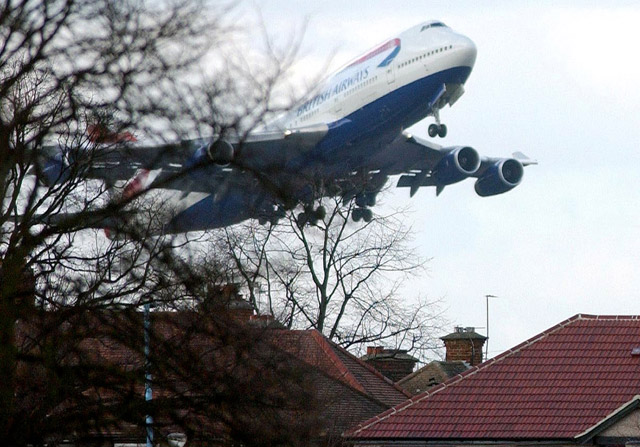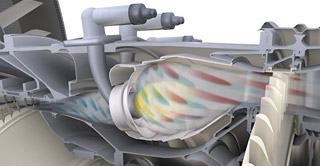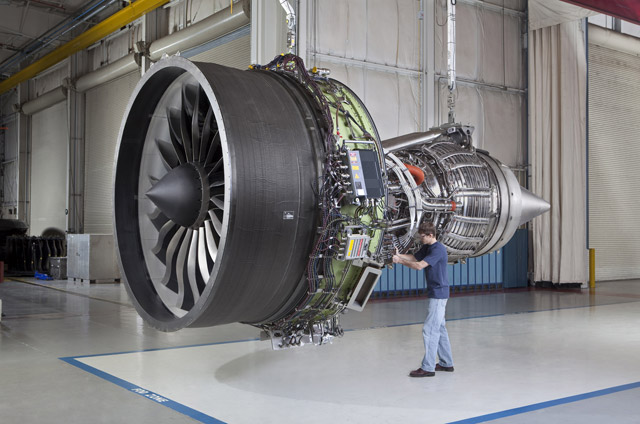When aviation hits the headlines over its impact on the environment, the focus is usually on climate change and greenhouse gas emissions - noise and air quality are generally overlooked. "When you look at how airlines communicate on their sustainability performance, it looks like we are heading towards a single-issue discussion," says Jeroen Kruijd, an airline sustainability expert at PwC. "We should be careful not to focus only on climate change." PwC report Building Trust In The Air reveals that while 70% of airlines report on their carbon emissions, only 40% report on NOX (nitrogen oxide) emissions and just 33% publish data on noise.
 |
|---|
| Rex Features Opponents to a third runway at London's Heathrow airport believe air-quality concerns could help them defeat expansion plans |
However, these issues, the focus of environmental concern for decades before climate change reared its head, have refused to go away. In fact they are often of more concern to airlines and airports, and dealing with them is crucial to the future health of the sector.
"These are areas where we have a bit of a black eye and need to continue to work hard," says Steve Csonka, head of "ecomagination" at GE Aviation. "Noise and local air quality have more impact on the debate in terms of stopping runway development and preventing operation at certain times of the day."
Indeed, opponents to a third runway at London's Heathrow airport believe air-quality concerns could help them defeat plans to expand the airport. One of the main air pollutants caused by aviation is nitrogen dioxide (NO2). EU rules based on World Health Organisation guidelines limit the amount of NO2 that can be present in the environment. This limit is consistently broken in London, which has one of the highest NO2 levels of any EU city.
IMPORTANT DRIVERS
Environmental group ClientEarth believes any plans for a third runway could be legally challenged because planning permission must be refused if a development is likely to breach air quality limits or worsen air quality where pollution already exceeds the limits.
Meanwhile, noise levels are one of the most important drivers of local opposition to airport expansions. The International Civil Aviation Organisation says that by 2020, the number of people affected by "annoying levels of aircraft noise" in Europe will be 40% higher than in 2001. ICAO catalogues the pollutants associated with aviation operations: NOX can cause lung irritation and lower resistance to respiratory infections, and has been linked to acid rain, visibility degradation, particle formation, and ozone formation. Carbon monoxide can cause cardiovascular effects, especially in those with heart conditions. Volatile organic compounds - such as benzene and acrolein - can cause eye and respiratory irritation, headaches, dizziness, visual disorders and memory impairment, and can contribute to ozone formation. Ozone can impair lung function and increase susceptibility to respiratory infection.
LOWER EMISSIONS
Innovations in engine technology such as GE Aviation's lean-burn technology help alleviate air quality issues. "We're getting about 50% lower NOX emissions than the latest standards," Csonka says. Fuel efficiency improvements also help - less fuel burnt means fewer emissions. However, Csonka warns that while the emphasis has been on NOX, focus will turn to particulates, where evidence is emerging of serious health effects such as premature mortality and aggravation of respiratory and cardiovascular disease.
 |
|---|
| GE "Ecomagination" underpins new GE designs |
"Aircraft are 70% more fuel-efficient than those of 50 years ago," adds Rob Morris, senior analyst at Flightglobal consultancy Ascend. He adds that the next generation will be 15-20% more efficient but the industry is expanding so rapidly these improvements are being cancelled out. Airbus, for example, expects the number of passenger aircraft to rise from 15,500 today to more than 32,500 by 2031.
Aviation noise and air-quality complaints range from the aircraft themselves to auxiliary power units, transfer buses, luggage trucks, construction, boilers and generators, as well as traffic to and from airports. However, impacts vary from site to site. "It can be difficult to isolate the different sources and their contribution," says Dr Claire Holman, an air quality specialist at global science and technology group Environ. "Every airport is different."
As a result, responses to noise and air quality come in a variety of guises that sometimes conflict with other priorities. One example of this is work being carried out on open rotor engines, which offer great improvements in fuel efficiency but still have to overcome concerns over increased noise.
Rolls-Royce associate engineering fellow Joe Walsh says: "One dilemma every manufacturer faces is that solutions to noise could lead to reduced overall performance. You achieve a quiet engine, but either you lose thrust or fuel efficiency. The challenge is to identify ways to reduce noise, but not at the expense of increased fuel use and CO2 emissions."
One major development has been the development of high-bypass-ratio engines. Walsh explains: "These engines have larger fans and generate thrust with less noise by sucking in a greater amount of air and moving it more slowly and, therefore, more smoothly through the engine. This makes engines quieter without losing power." The engines also have noise-absorbent panels around the fan, while Rolls-Royce also uses design to trap certain sound frequencies within the engine instead of allowing them to escape. Jet noise has also been abated via the introduction of serrated nozzles at the rear of the engines.
CAVITY TONES
With the EU having set a target of 65% reduction in aircraft noise disturbance by 2050 compared with 2000, design changes are needed not only in engines but in the aircraft they power. A lot of work has also gone in to reducing "cavity tones" from the airframe and future innovations are likely to include fairings in front of landing gear and smaller gaps between slats to cut slat noise, according to German aerospace research centre DLR.
 |
|---|
| GE GE's lean-burn technology is roughly halving standard NOX emissions, it says |
Future designs may see engines mounted above the wings or fuselage or within a "flying wing" to provide noise shielding. Changes will also be needed in air traffic management and flight operations.
A recent Airbus report, Smarter Skies, suggests aircraft could use assisted take-offs to allow steeper climb from airports to minimise noise and reach efficient cruise altitudes more rapidly. Free-glide landing approaches would also reduce noise and emissions. The report also suggests a number of low-emission ground operations such as switching aircraft engines off earlier and clearing runways more rapidly using "renewably powered taxiing carriages".
Noise and air quality clearly remain important issues for the industry even if, as Holman says, "people think they were solved in the 1990s. It is interesting that people are wound up by a long-term issue that they won't see the effects of for a long time [climate change] but have given up on more immediate issues."
Source: Flight International























